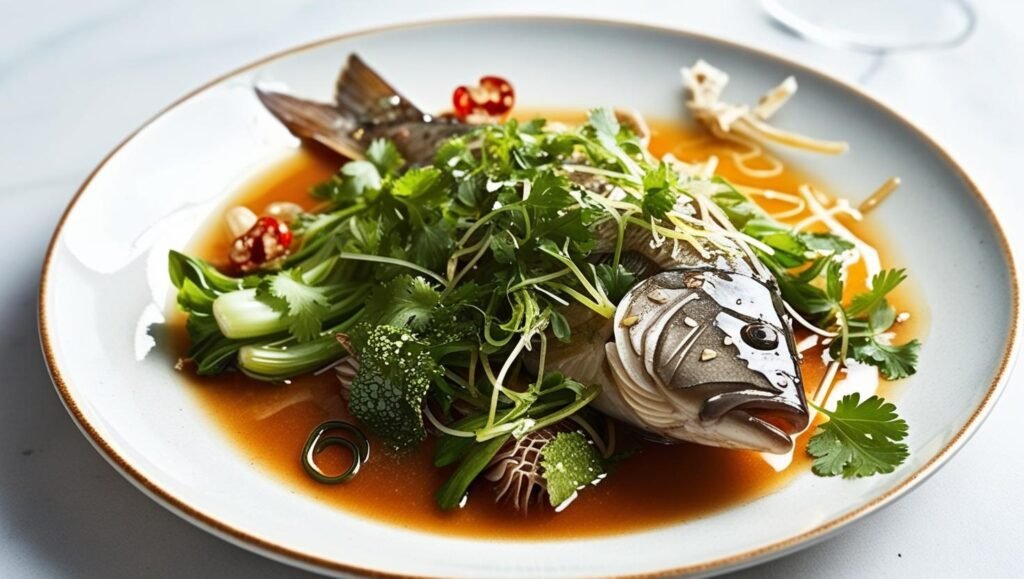Heartwarming Dish Rooted in Tradition
There’s something deeply comforting about the gentle aroma of Cantonese steamed fish wafting through the kitchen. This dish isn’t just food—it’s a memory, often the centerpiece at Chinese wedding banquets and Lunar New Year celebrations, where fish symbolizes good fortune and abundance.
I remember the first time I watched my grandmother prepare this dish. With graceful hands, she placed a whole fish on a steaming plate, layering it with ginger and scallions. The simplicity of the method, yet the incredible flavor, made it unforgettable. This recipe captures that same elegance—offering a healthy, quick, and delicious meal that feels special every time.

Why You’ll Love This Recipe
- Tender and Flaky Texture: Steaming locks in moisture, so the fish stays soft and juicy.
- Healthy and Low-Fat: No heavy oils or frying—just light, clean flavors.
- Rich in Cultural Significance: Especially popular during festivals, where serving the whole fish (head and tail intact) represents wholeness and unity.
- Quick and Beginner-Friendly: A perfect choice whether you’re cooking for family or impressing dinner guests.
Ingredients You’ll Need
Fish Options
- 1 whole white fish or fillet (sea bass, tilapia, flounder, haddock)
Seasonings
- 1 tablespoon soy sauce
- 1/8 teaspoon salt
- 1/8 teaspoon sugar
- 1/4 teaspoon pepper (adjust to taste)
Flavor Enhancers
- 1-inch ginger (julienned or thinly sliced)
- 2 scallions (julienned or sliced diagonally)
Aromatics & Oils
- 1 tablespoon Shaoxing wine (or dry sherry)
- 2 tablespoons peanut oil or vegetable oil
- 1 teaspoon sesame oil (optional, for extra fragrance)
Garnish & Spice
- 1-2 chili peppers (Fresno or bird’s-eye, thinly sliced)
- A handful of cilantro sprigs
How to Make Cantonese Steamed Fish
Step 1: Prepare the Fish and Aromatics
Place the fish on a heat-proof plate that fits comfortably into your steamer. Season both sides of the fish evenly with salt and pepper to enhance its natural flavor. Once seasoned, spread the julienned ginger, scallions, and thinly sliced chili generously over the fish, allowing these aromatics to infuse the fish during steaming.
Step 2: Steam the Fish
Set up your steamer or wok by adding 1 to 2 inches of water and bringing it to a gentle boil. Once the water is ready, place the prepared plate with the fish inside the steamer and cover it well. Let the fish steam for about 7 to 10 minutes. To ensure the fish is perfectly cooked, check for doneness by gently inserting a butter knife into the thickest part of the fish—the flesh should flake easily and the knife should glide through smoothly.
Step 3: Prepare the Flavorful Sauce
While the fish is steaming, prepare the sauce by mixing soy sauce, Shaoxing wine, sugar, and sesame oil together in a small bowl. In a separate pan, heat the peanut oil and add the remaining ginger and scallions. Sauté these aromatics for about one minute until they become fragrant and slightly softened. Pour the sauce mixture into the pan with the aromatics and allow it to simmer briefly to blend the flavors.
Step 4: Bring It All Together
Once the fish is fully steamed, carefully remove the plate from the steamer and drain any excess liquid that may have collected. Gently pour the hot sauce over the fish, ensuring it is evenly coated. To finish, garnish the fish with fresh cilantro sprigs and chili slices for added color and flavor. For an extra aromatic touch, heat a little additional oil separately and drizzle it over the fish just before serving to release the fragrant oils from the ginger and scallions, enhancing the overall presentation and taste.
Pro Tips and Variations
- Choosing Fresh Fish: Look for clear eyes, shiny skin, and a clean smell—avoid fishy odors.
- No Steamer? No Problem!: Use a large pot with a steaming rack or an upturned heat-proof bowl inside.
- For Extra Umami: Add a few drops of fish sauce or a splash of oyster sauce to the soy mixture.
- Serve With: Steamed jasmine rice, garlic bok choy, or light cucumber salad.
How to Store and Reheat Leftovers
- Fridge: Cool completely and store in an airtight container for up to 3 days.
- Freezer: Freeze for up to 3 months. Thaw overnight in the fridge before reheating.
- To Reheat: Steam gently or microwave with a splash of water to keep the fish moist.
Nutrition Information (Per Serving)
- Calories: 210 kcal
- Protein: 25 g
- Fat: 10 g
- Saturated Fat: 2 g
- Cholesterol: 60 mg
- Carbohydrates: 4 g
- Sugar: 1 g
Final Thoughts: A Simple Dish with Deep Meaning
Whether you’re honoring traditions or simply craving a healthy and comforting meal, Cantonese steamed fish delivers both flavor and meaning. It’s a dish that brings people together—simple enough for a weeknight, special enough for celebrations.
If you enjoyed this recipe, check out our Sweet and Sour Chicken or Egg Fried Rice for more easy Chinese favorites.
Cantonese Steamed Fish (FAQs)
Q: What type of fish is best for Cantonese steamed fish?
White fish like sea bass, tilapia, flounder, or haddock work well for Cantonese steamed fish because of their mild flavor and flaky texture. Whole fish is traditionally used for its cultural meaning, but fillets are a good option for convenience.
Q: Can I make Cantonese steamed fish without a steamer?
Yes, you can easily make this dish without a steamer by using a large pot with a steaming rack or placing an upturned heat-proof bowl inside the pot to support the plate. Cover tightly to keep the steam inside for perfect results.
Q: How do I know when steamed fish is perfectly cooked?
The fish is perfectly cooked when the flesh flakes easily and a butter knife slides smoothly into the thickest part. Avoid overcooking to keep the texture tender and juicy.
Q: What can I serve with Cantonese steamed fish?
This dish pairs beautifully with steamed jasmine rice, garlic bok choy, or a light cucumber salad. These simple sides complement the flavors without overpowering the delicate taste of the fish.
Q: How can I store and reheat leftover Cantonese steamed fish?
Store leftovers in an airtight container in the fridge for up to 3 days. To reheat, gently steam again or microwave with a splash of water to maintain moisture. You can also freeze for up to 3 months and thaw before reheating.
Q: Is Cantonese steamed fish healthy?
Yes, this recipe is naturally low in fat and high in protein, thanks to the steaming method. It uses minimal oil and relies on ginger, scallions, and soy sauce for flavor, making it a healthy option for balanced eating.

Cantonese Steamed Fish
Equipment
- Steamer or wok with steaming rack
- Heat-proof plate
- Sharp knife
- Small mixing bowl
- Pan for sauce preparation
Ingredients
- Fish Options
- 1 whole white fish or fillet sea bass, tilapia, flounder, haddock
- Seasonings
- 1 tablespoon soy sauce
- ⅛ teaspoon salt
- ⅛ teaspoon sugar
- ¼ teaspoon pepper adjust to taste
- Flavor Enhancers
- 1- inch ginger julienned or thinly sliced
- 2 scallions julienned or sliced diagonally
- Aromatics & Oils
- 1 tablespoon Shaoxing wine or dry sherry
- 2 tablespoons peanut oil or vegetable oil
- 1 teaspoon sesame oil optional, for extra fragrance
- Garnish & Spice
- 1 –2 chili peppers Fresno or bird’s-eye, thinly sliced
- A handful of cilantro sprigs
Instructions
- Step 1: Prepare the Fish and Aromatics
- Place the fish on a heat-proof plate that fits comfortably into your steamer. Season both sides evenly with salt and pepper. Spread the julienned ginger, scallions, and chili over the fish, allowing these aromatics to infuse flavor during steaming.
- Step 2: Steam the Fish
- Set up your steamer or wok with 1 to 2 inches of water and bring it to a gentle boil. Once ready, place the plate with the fish inside the steamer, cover, and steam for 7 to 10 minutes. Check doneness by inserting a butter knife into the thickest part—the flesh should flake easily and the knife should slide through smoothly.
- Step 3: Prepare the Flavorful Sauce
- While the fish is steaming, combine soy sauce, Shaoxing wine, sugar, and sesame oil in a small bowl. In a separate pan, heat the peanut oil and sauté the remaining ginger and scallions for about one minute until fragrant. Pour the sauce mixture into the pan and allow it to simmer briefly to blend the flavors.
- Step 4: Bring It All Together
- Once the fish is fully cooked, remove the plate from the steamer and drain any excess liquid. Gently pour the hot sauce over the fish, ensuring it is well coated. Garnish with fresh cilantro and chili slices. For an extra aromatic finish, heat a bit of additional oil and drizzle it over the fish just before serving.
Notes
Pro Tips and Variations
- Choosing Fresh Fish: Select fish with clear eyes, shiny skin, and a clean, fresh smell.
- No Steamer? Use a large pot with a steaming rack or an upside-down heat-proof bowl inside.
- For Extra Umami: Add a few drops of fish sauce or a splash of oyster sauce to the soy mixture.
- Serving Ideas: Pair with jasmine rice, stir-fried bok choy, or cucumber salad for a balanced meal.
Storage and Reheating Tips
- Refrigerate: Cool completely and store in an airtight container for up to 3 days.
- Freeze: Suitable for freezing up to 3 months. Thaw in the refrigerator before reheating.
- To Reheat: Steam gently or microwave with a splash of water to maintain moisture.
